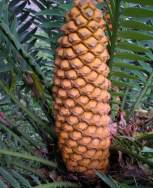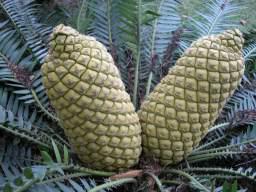Encephalartos lebomboensis
Encephalartos lebomboensis I.Verd.
Family: Zamiaceae
Common names: Lebombo cycad
SA Tree No: 14.8
Introduction
This cycad is said to be one of the most popular cycads in cultivation, although there is some confusion about its identity. Several populations of what were previously regarded as Encephalartos lebomboensis are now regarded as E. senticosus, including most of those found on the Lebombo Mountains.

Encephalartos lebomboensis was first described in 1949 by Dr Inez Verdoorn. Its centre of distribution was the Lebombo Mountains, stretching from northern KwaZulu-Natal through Swaziland and up into Mpumalanga. In 1995 Dr Piet Vorster re-named the plants from the central part of the geographic range (the Lebombo range from 50 km north of Siteki in Swaziland to the Josini Dam/Pongolapoort Dam in Kwazulu-Natal) as E. senticosus, based mainly on differences in their cones. It was from this latter site, when the dam was developed in the 1960s, that many cycads were collected and entered the nursery trade as E. lebomboensis, although they are now E. senticosus. Today E. lebomboensis is described as occuring in two areas, although this view is debated by some. There is a northern form around Mananga in Mpumalanga and a southern form centred around Piet Retief on the upper Pongola River Valley. Both forms are commonly found in cultivation and are easily obtainable at nurseries.
Description
Description
This is a medium to large cycad with stems which can grow to 4 m long. It is often procumbent with a crown of light to dark green, glossy leaves. It grows singly or in clumps of up to eight stems. It forms numerous suckers from the base and occasional offsets on the trunks. Stems of the Piet Retief form are shorter and stouter.
E.lebomboenesis - Piet Retief form (Photos: Johan Hurter)



The differences between the forms are slight, with the Piet Retief form having narrower leaflets and female cones which are usually solitary, barrel-shaped and greeny- cream, as opposed to more apricot yellow, egg-shaped cones of the Mananga form.
Mananga form of E. lebomboensis (Photos: Johan Hurter)



According the Vorster 1996, the main differences between E. lebomboensis and E. senticosus lie in the different shaped cone scales and that in E. lembonensis both male and female are usually solitary, although female cones are sometimes paired in the Mananga form, whereas E. senticosus has multiple cones. Male cones are sessile in E. lebomboensis, as opposed to having stalks/ peduncles in E. senticosus.
In E. lebomboensis female cones are apricot yellow, or light green and have flat cone scales. They are egg-shaped, (or barrel-shaped in the Piet Retief form), 400-450 mm long, 250-300 mm in diameter. Seedcoats (sarcotesta) are bright red.
Male cones are narrowly cylindrical, about 450 mm long and 120-150 mm in diameter and yellow to apricot in colour. The sporophyll faces are raised, but not drawn out and drooping.
Conservation Status
Status
This cycad was listed as Rare to Vulnerable by the Red Data List of southern African plants (Hilton-Taylor 1996). It is now regarded as Critically Endangered, especially the Mananga form.
Distribution and habitat
Distribution description
As mentioned earlier, E. lebomboenesis is centred in two separate locations in Swaziland and Mpumalanga i.e on the Lebombo Mountains around Mananga in what was formerly known as Kangwane and further south around Piet Retief. All forms grow on the slopes of high ridges and cliffs along river valleys. They grow in full sun. Climate is hot in summer with a rainfall of 625-750 mm and cool with frequent fogs and mists in winter (Whitelock 2002).
Specific name lebomboensis means 'of Lebombo' and refers to the Lebombo Mountains.
For more about the ecology of cycads in general please see Encephalartos horridus.
Growing Encephalartos lebomboensis
Grow
This cycad is suited to tropical and warm temperature regions. It is easily grown, hardy in full sun or light shade, relatively fast growing and transplants easily. It requires excellent drainage and may be damaged by heavy frosts, but can withstand light frosts. This cycad can be grown from seed or from the removal of suckers which transplant readily.
For more about the pests of cycads, please see Encephalartos horridus
When obtaining cycads for your garden, please be sure to buy from reputable sources and guard against doing anything that might endanger wild populations of these plants.
Yvonne Reynolds would like to thank Dr Piet Vorster, Dr John Donaldson, De Wet Bosenberg and Johann Hurter for their assistance with this article.
References
- GIDDY, C. 1974. Cycads of South Africa. Purnell, Cape Town.
- GOODE, D. 1986. Cycads of Africa. Struik, Cape Town.
- GOODE, D. 2001. Cycads of Africa, vol. 1. D & E Cycads of Africa, Gallomanor
- GROBBELAAR, N. 2002. Broodbome. Met spesiale verwysing na die Suider-Afrikaanse soorte. Pretoria.
- HILTON-TAYLOR, C. 1996. Red Data List of southern African plants. Strelitzia 4. National Botanical Institute, Pretoria.
- JONES, D.L. 1993. Cycads of the World: Ancient plants in today's landscape. Reed, New South Wales.
- JONES, D.L. 2002. Cycads of the World: Ancient plants in today's landscape. Smithsonian Institute, Washington D.C..
- KREMPIN, J. 1990. Palms and Cycads around the World. Horwitz Grahame, Australia.
- VORSTER, P. 1996. Encephalartos senticosus (Zamiaceae): a new species from Northern KwaZulu-Natal and Swaziland. SA Journal of Botany 62(2)76-79.
- VORSTER, P. 1995. The identity of Encephalartos lebomboensis in Proceedings of the Third International Conference on Cycad Biology. Stellenbosch 1995.
- CLAASSEN, I. 2000.Focus On Encephalartos Senticosus P.Vorster. Encephalartos 63:4-10.
- WHITELOCK, L.M. 2002. The cycads. Timber Press, Portland.
- GOLDING, J. S. and HURTER, P. J. H, 2003. A red data list of Africa's cycads and implications of considering life-history and threats.Biodiversity and Conservation 12: 507-528
Credits
Lou-Nita Le Roux
Lowveld National Botanical Garden
With additions by Yvonne Reynolds
April 2003
Plant Attributes:
Plant Type: Tree
SA Distribution: Mpumalanga
Soil type: Sandy
Flowering season:
PH: Neutral
Flower colour:
Aspect: Full Sun, Morning Sun (Semi Shade), Afternoon Sun (Semi Shade)
Gardening skill: Challenging
Special Features:
Horticultural zones








Rate this article
Article well written and informative
Rate this plant
Is this an interesting plant?
Login to add your Comment
Back to topNot registered yet? Click here to register.